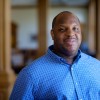This article is more than 5 years old.
Several weeks ago, I attended the NASIG annual conference in Buffalo, New York. This year, I took a special interest in sessions that dealt with licensing, such as using templates and “model” licenses as well as how to effectively negotiate licenses without an extensive legal background. The care and feeding of electronic resources was also a highlight, giving me a chance to brush up on concepts such as TERMS (Techniques for Electronic Resource Management) which I learned about while attending the virtual ER&L Conference earlier in the spring.
I did find three additional takeaways from this year’s conference, all of which I found interesting in their own way. If you have any questions about them, please let me know.
Vision sessions. NASIG has always had thought-provoking vision sessions, but this year there were two sessions centered on a similar idea but operating as counterpoints. The first session was facilitated by Bryan Alexander who spoke on “Libraries and Mobile Technologies in the Age of the Visible College”. Mr. Alexander explained how mobile technology has changed the world of higher education in recent years, starting with smartphones and extending into touchscreen interfaces, clickers, smart pens, and even marker-based augmented reality (such as QR codes). Mr. Alexander also highlighted four possible futures for technology on college campuses- phantom learning, open world, silo world, and alternate residential. Although each concept has merit there is an uncertainty about which one would be the actual direction to be followed.
Conversely, the title of the other session was “Googlization and the Challenge of Big Data, or Knowledge and Integrity in the Era of Big Data”, presented by Siva Vaidhyanathan. With the knowledge of Edward Snowden and his connection to the NSA entering the national dialogue, as well as the revelations of Google, Verizon and other corporations turning consumer data over to government agencies, Mr. Vaidhyanathan discussed the downside to big data. He proposed that the silos around the management of data, particularly those since the abuses of the 1970s, have eroded steadily over the decades since. In Mr. Vaidhyanathan’s words, we live in a cryptopticon, a stage beyond Bentham’s Panopticon where we’re being monitored for a variety of commercial purposes, such as grocery store discount cards that are linked to our buying habits. Digital literacy instruction, he suggested, was the next frontier for information literacy itself. For further explanation, he suggested the films Minority Report, The Lives of Others, and a double feature of The Conversation and Enemy of the State.
E-Resources Acquisition Checklist. This was one of the most productive sessions of its kind I’ve attended. Based on the TERMS guidelines, it focused on the e-resource lifecycle that I could remember as largely nebulous only a few years ago. Now, the basic steps have been captured so that anyone who works with electronic resources can see the entire landscape.
These procedures also incorporate the process of re-evaluating an e-resource, a definite departure from the standards of print materials. By doing so, it incorporates a measure of flexibility for resources that may have a shorter span of value to an institution and a set of guidelines for either their removal or replacement. With the growing number of similar databases on the market, this process can have added value in the years to come.
Showcase. This was a new feature, which went far beyond the poster sessions of previous conferences. In addition to posters which highlighted what a particular library was doing well in terms of technical services, this was a chance for libraries to feature what they were doing well as an organization. This was a “show and tell”, and the Showcase featured a broad mixture of ideas. There were two that caught my eye:
- A demonstration of 3-D printing, which students are using to build constructs for classwork and special projects.
- A description of how one library used relaxation techniques for stressed-out students during exams, including pet therapy. The idea of puppies in the library was a popular one!
Another memorable event of note from Buffalo was this year’s all-conference reception. It was held at the Pierce Arrow Museum, which featured the cars from the popular luxury car manufacturers of the early twentieth century. This was a unique site for the reception because of the conversation pieces (cars) that held everyone’s interest. I had my first taste of sponge candy (pure heaven) and saw the construction of a gas station that was designed by Frank Lloyd Wright but was never built. This glimpse of architectural history was remarkable. If you’d like to see all of my photos from Buffalo, follow this link.

